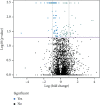Differential Expression and PAH Degradation: What Burkholderia vietnamiensi s G4 Can Tell Us?
- PMID: 32908529
- PMCID: PMC7474390
- DOI: 10.1155/2020/8831331
Differential Expression and PAH Degradation: What Burkholderia vietnamiensi s G4 Can Tell Us?
Abstract
Petroleum is the major energy matrix in the world whose refining generates chemical byproducts that may damage the environment. Among such waste, polycyclic aromatic hydrocarbons (PAH) are considered persistent pollutants. Sixteen of these are considered priority for remediation, and among them is benzo(a)pyrene. Amid remediation techniques, bioremediation stands out. The genus Burkholderia is amongst the microorganisms known for being capable of degrading persistent compounds; its strains are used as models to study such ability. High-throughput sequencing allows researchers to reach a wider knowledge about biodegradation by bacteria. Using transcripts and mRNA analysis, the genomic regions involved in this aptitude can be detected. To unravel these processes, we used the model B. vietnamiensis strain G4 in two experimental groups: one was exposed to benzo(a)pyrene and the other one (control) was not. Six transcriptomes were generated from each group aiming to compare gene expression and infer which genes are involved in degradation pathways. One hundred fifty-six genes were differentially expressed in the benzo(a)pyrene exposed group, from which 33% are involved in catalytic activity. Among these, the most significant genomic regions were phenylacetic acid degradation protein paaN, involved in the degradation of organic compounds to obtain energy; oxidoreductase FAD-binding subunit, related to the regulation of electrons within groups of dioxygenase enzymes with potential to cleave benzene rings; and dehydrogenase, described as accountable for phenol degradation. These data provide the basis for understanding the bioremediation of benzo(a)pyrene and the possible applications of this strain in polluted environments.
Copyright © 2020 Guilherme Pinto Cauduro et al.
Conflict of interest statement
The authors declare that there are no conflicts of interest regarding the publication of this paper.
Figures



Similar articles
-
Evaluation of Differentially Expressed Candidate Genes in Benzo[a]pyrene Degradation by Burkholderia vietnamiensis G4.Mol Biotechnol. 2024 Sep 19. doi: 10.1007/s12033-024-01284-6. Online ahead of print. Mol Biotechnol. 2024. PMID: 39298104
-
Burkholderia vietnamiensis G4 as a biological agent in bioremediation processes of polycyclic aromatic hydrocarbons in sludge farms.Environ Monit Assess. 2022 Nov 17;195(1):116. doi: 10.1007/s10661-022-10733-1. Environ Monit Assess. 2022. PMID: 36394643
-
New benzo(a)pyrene-degrading strains of the Burkholderia cepacia complex prospected from activated sludge in a petrochemical wastewater treatment plant.Environ Monit Assess. 2021 Mar 6;193(4):163. doi: 10.1007/s10661-021-08952-z. Environ Monit Assess. 2021. PMID: 33675444
-
Comprehensive review on toxicity of persistent organic pollutants from petroleum refinery waste and their degradation by microorganisms.Chemosphere. 2017 Dec;188:280-291. doi: 10.1016/j.chemosphere.2017.09.005. Epub 2017 Sep 4. Chemosphere. 2017. PMID: 28888116 Review.
-
Biodegradation of polycyclic aromatic hydrocarbons by Trichoderma species: a mini review.Environ Sci Pollut Res Int. 2015 Dec;22(24):19426-33. doi: 10.1007/s11356-015-5602-4. Environ Sci Pollut Res Int. 2015. PMID: 26498812 Review.
Cited by
-
Determining the Benzo[a]pyrene Degradation, Tolerance, and Adsorption Mechanisms of Kefir-Derived Bacterium Bacillus mojavensis TC-5.Foods. 2025 Aug 4;14(15):2727. doi: 10.3390/foods14152727. Foods. 2025. PMID: 40807664 Free PMC article.
References
-
- Tonini R. M. C. W., Rezende C. E., Grativol A. D. Degradação e biorremediação de compostos do petróleo por bactérias: revisão. Oecologia Australis. 2010;14(4):1025–1035. doi: 10.4257/oeco.2010.1404.11. - DOI
-
- Mackay D., Callcott D. Partitioning and physical chemical properties of PAHs. The Handbook of Environmental Chemistry. 1998:325–345. doi: 10.1007/978-3-540-49697-7_8. - DOI
-
- Juhasz A. L., Naidu R. Bioremediation of high molecular weight polycyclic aromatic hydrocarbons: a review of the microbial degradation of benzo[a]pyrene. International Biodeterioration & Biodegradation. 2000;45(1-2):57–88. doi: 10.1016/s0964-8305(00)00052-4. - DOI
-
- Marston C. P., Pereira C., Ferguson J., et al. Effect of a complex environmental mixture from coal tar containing polycyclic aromatic hydrocarbons (PAH) on the tumor initiation, PAH-DNA binding and metabolic activation of carcinogenic PAH in mouse epidermis. Carcinogenesis. 2001;22(7):1077–1086. doi: 10.1093/carcin/22.7.107710.1093/carcin/22.7.1077. - DOI - PubMed
LinkOut - more resources
Full Text Sources

